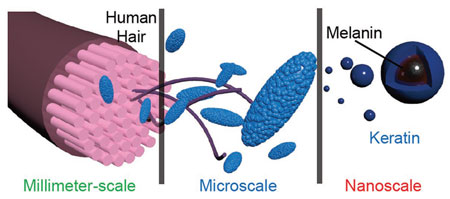| Apr 25, 2019 | |
Nanostructures from hair to aid biomedical engineering(Nanowerk News) Researchers have explored the hierarchical micro-/nanostructures from human hair and isolated these structures as a new kind of biomaterial. |
|
| Reporting their findings in Advanced Materials ("Hierarchical Micro-/Nanostructures from Human Hair for Biomedical Applications"), a team from Wuhan University in China demonstrated the initial feasibility of several potential applications, such as protecting cells from UV irradiation; delaying oxidation-induced cataract formation; rescuing mice from vein thrombosis; and suppressing tumor growth. | |
| From a chemical perspective, hair is mainly composed of melanins and keratins, and these two polymers are ideal materials for biomedical applications. As a perfect match of structural keratins and functional melanins, hierarchical structures in hair might provide a valuable treasure for various biomedical applications. | |
| In their investigations, the researchers therefore broke down human hair into hierarchical microparticles and hierarchical nanoparticles. | |
 |
|
| Schematic illustration of the hierarchical micro-/nanostructures from human hair. (Reprinted with permission by Wiley-VCH Verlag) | |
| They verified that cortex fibers were structurally composed of micrometer-sized melanosomes (hair microparticles, HMP) and that melanosomes appear to be assembled from nanoparticles (hair nanoparticles, HNP) with a diameter of around 100 nm. Both HMP and HNP are were chemically composed of keratins (HMP: 47%; HNP: 43%) and melanin (HMP and HNP:both 44%). | |
| After investigating the detail micro-/nanostructure of human hair, the team further analyzed thecomponents of both HMP and HNP. Both exhibit a similar amino acid composition. | |
| Since melanin can absorb light from the ultraviolet to near infrared region, the scientists speculated that HMP and HNP might be able to convert absorbed light energy into heat. Next, the photothermal conversion capacity of HMP and HNP inherited from melanin was studied, HMP and HNP showed satisfactory photothermal conversion efficiency (49.8% and 39.3%, respectively) and high photostability. | |
| Melanin also is well-known for its redox equilibrium ability by scavenging phenolic hydroxyl with free radicals. Since chronic oxidative stress is a major factor in inducing cataract, the team further evaluated biomedical potential of HMP in cataract prevention. | |
| Apart from its redox equilibrium ability, melanin can also act as a photoprotection polymer in living organisms for its strong absorption of UV light. Inspired by this, the researchers evaluated the UV-protection effect of HMP. | |
| Concluding from their promising findings, the authors conclude that, owing to their versatile functions (drug delivery, photothermal conversion, and redox equilibrium regulation), the medical relevance of HMP and HNP might inspire the rational design of smart biomedical materials. | |
| Furthermore, the strategy of preparing biomaterials from abundant human hair might constitute a potent tool for producing autogenous materials from patients themselves to overcome the drawback of nanomedicine in causing immediate hypersensitivity reactions. |
 By
Michael
Berger
– Michael is author of three books by the Royal Society of Chemistry:
Nano-Society: Pushing the Boundaries of Technology,
Nanotechnology: The Future is Tiny, and
Nanoengineering: The Skills and Tools Making Technology Invisible
Copyright ©
Nanowerk LLC
By
Michael
Berger
– Michael is author of three books by the Royal Society of Chemistry:
Nano-Society: Pushing the Boundaries of Technology,
Nanotechnology: The Future is Tiny, and
Nanoengineering: The Skills and Tools Making Technology Invisible
Copyright ©
Nanowerk LLC
|
|
|
Subscribe to a free copy of one of our daily Nanowerk Newsletter Email Digests with a compilation of all of the day's news. |
